
Quadrifora is a type of four-light window. It appears in towers and belfries on top floors, where it is necessary to lighten the structure with wider openings. The quadrifora can also be a group closely set windows. [1]

Quadrifora is a type of four-light window. It appears in towers and belfries on top floors, where it is necessary to lighten the structure with wider openings. The quadrifora can also be a group closely set windows. [1]
The quadrifora is divided vertically in four parts by three small columns or pilasters, on which four arches rest, round or pointed. [2] Sometimes, the quadrifora is framed by a further larger arch; the space among the arches may be decorated by a coat of arms or a small circular opening. [3]
Less popular than the bifora or trifora, the quadrifora was nevertheless used in the Romanesque, Gothic, and Renaissance periods. In the 19th century, it came back in vogue in the period of eclecticism and the revival of old styles. Compared to the trifora, the quadrifora was generally used for larger and more ornate openings.

Diocletian windows, also called thermal windows, are large semicircular windows characteristic of the enormous public baths (thermae) of Ancient Rome. They have been revived on a limited basis by some classical revivalist architects in more modern times.

The Palazzo Clary is a Late Renaissance Venetian palace facing the Giudecca Canal alongside the fondamenta Zattere by the ponte longo in Venice's Dorsoduro. It was originally built in the 17th century for a Venetian noble family. In the early 19th century, the palazzo is known as Palazzo Clary, named after it was bought by the prince Clary-Aldringen. The neighboring building is Palazzo Giustinian Recanati.
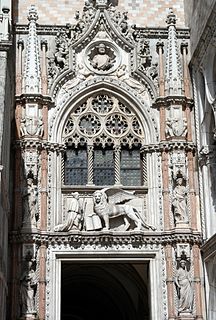
Trifora is a type of three-light window. The trifora usually appears in towers and belfries—on the top floors, where it is necessary to lighten the structure with wider openings.

A bifora is a type of window divided vertically in two openings by a small column or a pilaster; the openings are topped by arches, round or pointed. Sometimes the bifora is framed by a further arch; the space between the two arches may be decorated with a coat of arms or a small circular opening.
Polifora is a type of the multi-light window. It appears in towers and belfries on top floors, where it is necessary to lighten the structure with wider openings. The term polifora usually refers to the window with at least five parts.

Monofora is a type of the single-light window, usually narrow, crowned by an arch, and decorated by small columns or pilasters.

Palazzo Savorgnan is a palace in Venice, Italy, located in the Cannaregio district and overlooking Canale di Cannaregio, to the right of Palazzo Priuli Manfrin.

Palazzo Nani is a Renaissance palace in the Cannaregio district of Venice, Italy.
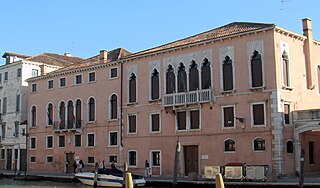
Palazzo Testa is a small Gothic palace in Venice, Italy, located in the Cannaregio district and overlooking the Canale di Cannaregio.

Palazzo Correr Contarini Zorzi is a Renaissance palace in Venice, Italy, overlooking the Grand Canal and locating in the Cannaregio district between Palazzo Querini Papozze and Palazzo Gritti. The palazzo is also known as Ca' dei Cuori, a family whose wrought iron coats of arms is present on the façade.

Palazzo Emo Diedo is a neoclassical palace in Venice, Italy located in the Santa Croce district, overlooking the Grand Canal, opposite the railway station. The building is located near San Simeone Piccolo.

Palazzo Adoldo is a Renaissance palace in Venice, located in the Santa Croce district and overlooking the Grand Canal. On the right there is the church of San Simeon Piccolo, on the left—Palazzo Foscari Contarini.

Palazzo Giustinian Pesaro is a Gothic palace located in Venice, Italy, in the Cannaregio district and overlooking the Grand Canal. The palazzo is situated between Ca' d'Oro and Palazzo Morosini Sagredo.

Palazzo Falier is a civil building located in Venice, Italy in the Cannaregio district. The palazzo is particularly known for having been the home of Marin Falier, Doge of the Republic of Venice, who was executed for attempting a coup d'état.
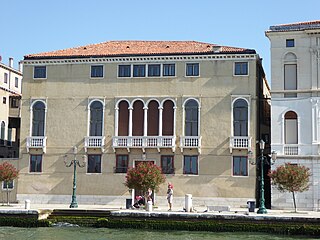
Palazzo Giustinian Recanati is a palace in Venice, Italy, located in the Dorsoduro district and overlooking the Giudecca Canal, just to the left of Palazzo Clary.
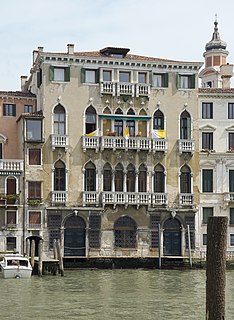
Palazzo Michiel del Brusà is a palace located in Venice, more precisely in the Cannaregio district, and overlooking the Grand Canal. The building is located between Palazzo Michiel dalle Colonne and Palazzo Smith Mangilli Valmarana.
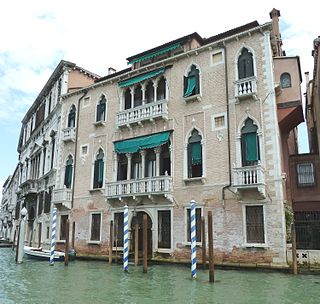
Palazzo Erizzo Nani Mocenigo is a palace in Venice located in the San Marco district and overlooking the Grand Canal between Palazzo Da Lezze and Palazzo Contarini delle Figure.
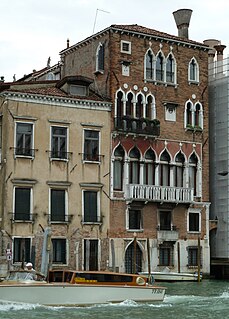
Palazzo Barbaro Wolkoff is a Venetian civil building located in the Dorsoduro district and overlooking the Grand Canal between Ca' Dario and Casa Salviati.

Palazzo Vitturi is a palace in Venice, Italy located in the Castello district, on the north-eastern side of Campo Santa Maria Formosa, of which the palazzo is the oldest building. The palace is mentioned in the works of Sansovino.
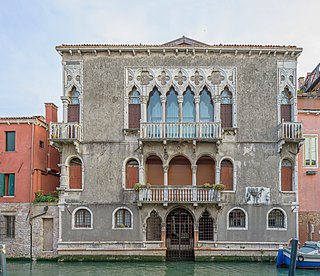
Palazzo Mastelli del Cammello is a Gothic palace in Venice, Italy. It is located in Cannaregio district, on the Campo dei Mori and the Rio Madonna dell'Orto.